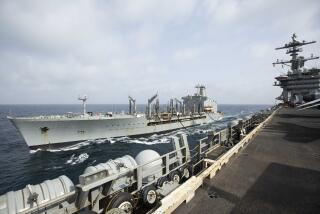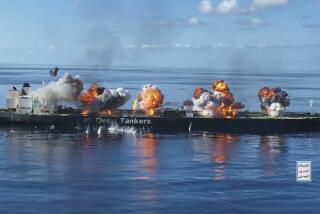Mine used in ship attack looks a lot like Iranian weapons, U.S. Navy expert says

Reporting from FUJAIRAH, United Arab Emirates — The limpet mines used to attack a Japanese-owned oil tanker near the Strait of Hormuz last week bore “a striking resemblance” to similar mines displayed by Iran, a U.S. Navy explosives expert said Wednesday, stopping short of directly blaming Tehran for the assault.
Iran has denied being involved in the attack last Thursday that hit the Japanese tanker Kokuka Courageous and also the Norwegian-owned Front Altair.
The comments by Cmdr. Sean Kido came as the Navy showed reporters pieces of debris and a magnet it says Iran’s Revolutionary Guard left behind when it spirited away an unexploded limpet mine after the June 13 attack in the Gulf of Oman. Iran has not acknowledged taking the mine.
Kido also stressed that the damage done to the Kokuka Courageous was “not consistent with an external flying object hitting the ship,” despite the ship’s owner blaming “flying objects” for the damage in the attack.
Meanwhile, a rocket hit an oil-drilling site in Iraq’s southern Basra province early Wednesday, striking inside a compound housing energy giant Exxon Mobil and other foreign oil companies and wounding three local workers, one seriously, Iraqi officials said.
The attack on the oil tankers came against the backdrop of heightened tensions between the U.S. and Iran that take root in President Trump’s decision to withdraw from Tehran’s nuclear deal with world powers a year ago.
Iran recently has quadrupled its production of low-enriched uranium and threatened to boost its enrichment closer to weapons-grade levels, trying to pressure Europe for new terms to the 2015 deal.
In recent weeks, the U.S. has sped an aircraft carrier to the Mideast and deployed additional troops to the tens of thousands already here. Mysterious attacks also have targeted oil tankers as Iranian-allied Houthi rebels launched bomb-laden drones into Saudi Arabia.
All this has raised fears that a miscalculation or further rise in tensions could push the U.S. and Iran into an open conflict, some 40 years after Tehran’s Islamic Revolution.
The U.S. Navy briefed foreign journalists on Wednesday at a 5th Fleet base near Fujairah, an Emirati port city some 130 miles northeast of the capital, Abu Dhabi. There they showed journalists debris recovered from the Kokuka Courageous, which they described as including aluminum and composite metals.
They also showed a magnet they described as being left behind by the Revolutionary Guard — one of six apparently used to stick the unexploded limpet mine to the ship’s hull. Sailors said it took two of them and a crowbar to pry it off the ship.
Those pieces put together have U.S. sailors suspecting the limpet mine came from Iran.
They showed a picture previously shared among weapons experts of a limpet mine on display in Iran, which they said resembled the one they suspected was used on the ship. That picture showed a conical mine, some 90 pounds in weight, on display with a sign next to it identifying it as being produced by a research company affiliated with the Revolutionary Guard.
“The limpet mine that was used does bear a striking resemblance to that which has been publicly displayed in Iranian military parades,” Kido said. “There are distinguishing features.”
Kido declined to elaborate. Iran’s mission to the U.N. did not immediately respond to a request for comment.
The mines were placed above the vessel’s water line. One exploded, punching through the double-hulled ship and sparking a brief fire. The placement of the mines on the vessel makes it “not appear that the intention was to sink the vessel,” Kido said.
“The damage we observed is consistent with a limpet mine attack; it is not consistent with an external flying object hitting the ship,” Kido said.
Authorities also recovered a handprint and fingerprints, he said. “We recovered biometric information ... which can be used to build a criminal case to hold the individuals responsible accountable.” He did not offer more details.
The second vessel involved in the attack, the Norwegian-owned Front Altair, caught fire and sent black smoke up into the air that was visible from space by satellites. Kido did not explain why the U.S. had no immediate evidence from that vessel. Both are now anchored off the eastern coast of the United Arab Emirates.
He also declined to discuss an earlier, May 12 attack on four oil tankers off the coast of Fujairah near the U.S. base, which America similarly blames on an Iranian limpet mine attack. Analysts also believe those attacks came from limpet mines.
In Iraq on Wednesday, a Katyusha rocket landed at dawn in the Zubair and Rumeila oil fields camp, operated by the Iraqi Drilling company, where Exxon Mobil and other companies have caravans housing their workers, security official Mahdi Raykan said.
Exxon Mobil, based in Irving, Texas, did not immediately respond to a request for comment. In May, it evacuated staff from the West Qurna 1 oil field in Basra province.
As Washington-Tehran tensions escalated, there have been concerns that Iraq could once again get caught in the middle between its two top allies. The country hosts more than 5,000 U.S. troops and is home to powerful Iranian-backed militias, some of whom want those U.S. forces to leave.
In May, the U.S. evacuated nonessential diplomatic staff from Iraq. That came before a missile landed in Baghdad’s Green Zone, near the sprawling U.S. Embassy.
No one claimed responsibility for Wednesday’s attack, and Iraqi oil exports were unaffected.
More to Read
Get the L.A. Times Politics newsletter
Deeply reported insights into legislation, politics and policy from Sacramento, Washington and beyond. In your inbox three times per week.
You may occasionally receive promotional content from the Los Angeles Times.










